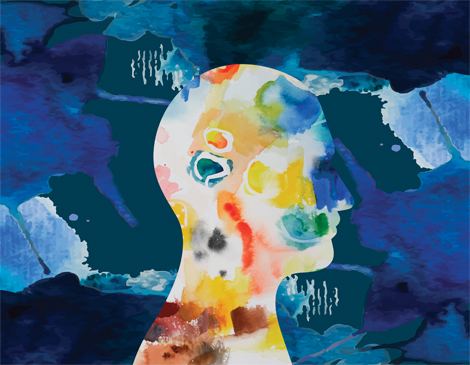It’s a harsh reality. Approximately one in five American adults experience mental illness each year, with one in 25 living with a serious mental illness such as schizophrenia, major depression or bipolar disorder, according to the National Alliance on Mental Illness.
But there’s hope, says Dr. Joseph Calabrese, University Hospitals’ director of the mood disorders program.
“People who seek treatment for mental illness really do well. The primary problem is, most people don’t pursue treatment,” says
Calabrese. “The best thing we can do now is to help people understand that treatments have advanced.”
Doctors roughly had two medications to use for mental illness in the ’90s — Prozac for depression and lithium for bipolar disorder. In 2017, 145 medicines were in development by biopharmaceutical research companies to help with mental illness, according to NAMI.
“We have medications that work and don’t have the side effect burden that older medications have,” Calabrese says.
Attention Deficit Hyperactivity Disorder
What It Is: Commonly known as ADHD, this developmental disorder relates to struggling with attention, hyperactivity and acting impulsively. “In a subgroup of patients, attention deficit disorder results in marked impairment and should be treated with a medication,” says Calabrese.
The Treatment: It can take a while to find the right medication match. What works well for one might not work for another. The benefit of medications — stimulants, nonstimulants and antidepressants — is improved attention span, an ability to deal with frustration and, because of this, better relationships. Behavioral therapy is necessary for a person to manage more serious symptoms and function in learning environments.
Anxiety Disorders
What It Is: There are two primary anxiety disorders. Generalized anxiety disorder is chronic, exaggerated worrying about everyday life that makes it hard to focus and complete tasks. It can cause physical symptoms including headache and nausea. Panic disorder is when a person experiences panic attacks that can be mistaken for a heart attack. Other anxiety disorders include social anxiety and phobias. According to NAMI, anxiety is the most common mental illness, affecting about 42 million adults in the U.S.
The Treatment: Medication combined with counseling or psychotherapy is proven to be effective. “People need both medical and behavioral intervention,” Calabrese says. “Medicine is the biological intervention, and behavioral therapy teaches people to manage symptoms.”
Autism
What It Is: This developmental disorder makes it difficult to socialize and communicate with others. “Autism can be accompanied with anxiety, depression and psychotic symptoms — traditional symptoms you see in psychiatry — and it’s an illness that needs to be addressed by multiple disciplines,” says Calabrese. A team of doctors — usually a psychiatrist, a doctor focused on developmental disorders and a neurologist — work together on a treatment plan.
The Treatment: There are no medications labeled for autism, but off-label medications are used to address irritability. Anxiety or depression is addressed with medications that treat those illnesses. Behavioral therapy can range from applied behavior analysis to teach positive behaviors, floor time as a play-based strategy to teach speech and social skills, and specialized treatment including speech therapy, occupational therapy and education plans that create pathways for different learners in the school environment.
Bipolar Disorder
What It Is: A person experiences dramatic shifts in mood, energy and thinking — highs known as mania and lows resulting in depression. People with bipolar disorder who have psychotic symptoms (hallucinations and delusions) can be misdiagnosed with schizophrenia. Mania or hypomania (a milder symptom) is the defining characteristic of bipolar disorder.
The Treatment: Medications include mood stabilizers, antipsychotic drugs and sometimes antidepressants. This combined with psychotherapy and self-management strategies can help a person deal with symptoms and function well in school, at work and in the community.
Borderline Personality Disorder
What It Is: This condition makes it difficult to regulate emotions and to stabilize after emotions are triggered. More than half of those labeled with this disorder are trauma survivors. “Someone who experienced trauma is going to develop adaptations to help them cope with that, which can involve aggressive behavior or avoidance, emotional reactivity or dysregulation,” says Dr. Cyndi Vrabel, medical director of FrontLine Service. Borderline personality symptoms are present in other illnesses, including bipolar disorder, post-traumatic stress disorder, anxiety and eating disorders.
The Treatment: Psychotherapy teaches coping skills to manage emotional dysregulation. Medications can be used off-label (there’s no drug specifically for borderline personality disorder) to treat symptoms like stabilizing mood.
Depression
What It Is: It’s not feeling blue or down. Depression is a serious mental health condition with symptoms that range depending on the person: sleep and appetite changes, lack of concentration, energy loss, disinterest in activities, feeling guilty or hopeless, and suicidal thoughts are some common signs. According to NAMI, depression can be triggered by a crisis, illness or occur spontaneously.
The Treatment: Depression can be managed effectively when it is caught early, diagnosed and treated. A range of medications are available to address depression, including antidepressants, antipsychotics and mood stabilizers. Antidepressants without the “side effect burden” of weight gain, for example, are now on the scene. Calabrese points to Lamictal (lamotrigine) as one example. Medicine should be combined with other therapies, such as psychotherapy. Exercise, acupuncture and meditation can complement forms of clinical intervention.
Dissociative Disorders
What it is: A survivor of abuse or combat flashes back to a terrible memory. A person’s mind might disassociate from what happened to protect them from the original trauma. Dissociative disorders often sit alongside anxiety, depression, post-traumatic stress disorder and suicidal thoughts. “Trauma survivors many times can have dissociative disorders,” Vrabel says.
The Treatment: Antidepressants can address symptoms related to dissociative disorder, and psychotherapy is also part of the treatment protocol.
Eating Disorders
What It Is: Eating disorders have the highest rate of mortality of any psychiatric illness, says Dr. Mark Warren, chief medical officer of the Emily Program, which treats people who struggle with anorexia, bulimia and a range of eating disorders, including avoidant/restrictive food intake disorder. The high mortality rate is due to the stigma associated with these illnesses, along with medical complications and suicide, that keeps people from getting help. “When recognized early, they have a very high chance of recovery,” Warren says. Symptoms include unexplained weight loss, missing meals, disappearing after meals, finding food hidden in odd places. “If your child stops participating in normal activities like going out for pizza with friends, I would have concern,” he says. “If you think there is something going on, there probably is.”
The Treatment: Involving the family or supportive loved ones can help break the cycle of starvation in the case of anorexia. “The key is standing together in a collaborative way,” Warren says. With support, a person can begin eating in healthy ways — and the brain relearns a desire for food. “Through repetition, learning, nutrition, positive social cues, and family and peer support, the brain can develop in ways where the eating disorder thoughts and behaviors can truly be eliminated.”
Obsessive-Compulsive Disorder
What It Is: It could be washing your hands 56 times before leaving the house. Commonly called OCD, these doubts about doing something, like locking the door, intrude on your life in such a way that you can’t focus. These repetitive, unwanted obsessions and irrational, excessive urges to do certain actions derail a person from everyday life.
The Treatment: A class of antidepressants called selective serotonin reuptake inhibitors can reduce obsessions and compulsions. This combined with psychotherapy can help a person manage OCD.
Post-Traumatic Stress Disorder
What It Is: PTSD can occur after a person has lived through a traumatic event such as abuse, an accident, violence, military combat or natural disaster. Symptoms include dissociative experiences or reliving the trauma with flashbacks, bad dreams or thoughts that won’t go away. Avoidance is also common, as is hyperarousal — constantly being on guard. PTSD is often accompanied with depression and anxiety.
The Treatment: Therapy to process the trauma, whether in a group or one-on-one, can be effective on its own or with medications. Service animals can ease the symptoms as well.
Psychosis
What It Is: It’s a break from reality. Psychosis is a set of symptoms (not an illness), and it accompanies a range of mental health conditions, including bipolar disorder and schizophrenia. Some early signs of psychosis include hearing, seeing, tasting or believing things that others do not. A person might have thoughts that he or she can’t shake, no matter what others say. Really strong emotions or lack of emotion is also an indicator, as is trouble thinking clearly or concentrating. “When we talk about psychosis, we are usually referring to auditory hallucinations, delusional or disorganized thinking,” says Vrabel.
The Treatment: A combination of psychotherapy and medication can be used to treat psychosis symptoms.
Schizophrenia
What It Is: Schizophrenia is a serious mental illness that affects about 1 percent of Americans who struggle to think clearly, manage emotions, make decisions and function in relationships. “It’s a spectrum of disorders that has a basis in genetics, but environmental stressors can also impact the condition,” Vrabel explains. “People with schizophrenia have auditory hallucinations — they hear voices — or fixed false beliefs, which we call delusional thinking. Disorganized thoughts lead to difficulty communicating because speech can be disorganized.” Schizoaffective disorder, which is less known, shares the symptoms of schizophrenia — along with either depression or mania.
The Treatment: We can’t cure schizophrenia — it’s a chronic illness. “There are many things we do to impact the symptoms and provide support,” Vrabel says. “There are many people with schizophrenia who are professionals and have good qualities of life.” Medications help organize thinking and can also be used to address accompanying anxiety, depression and psychosis.
A new medicine used to treat schizophrenia called Rexulti (brexpiprazole) is also effective for bipolar disorder. “What makes this drug novel is it has a very broad spectrum of efficacy, which improves people’s chances of responding to the treatment,” says Dr. Joseph Calabrese, University Hospitals’ director of the mood disorders program who was involved in the development of the drug.
There are many reasons why people who struggle with their mental health also struggle to take a daily pill. But options, such as risperidone, a two-week injectable that helps manage schizophrenia are giving patients relief. “Long-acting injectables give individuals the choice of receiving medication even once a month or every few months, which can stabilize symptoms,” says Dr. Cyndi Vrabel, medical director of FrontLine Service. “This has been amazing in terms of the recovery we see in people who have struggled for many years with taking medications.”




